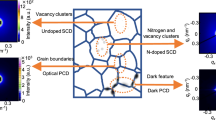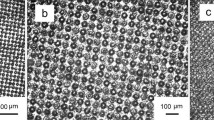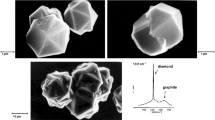Abstract
Diamond windows were heated at 700-900 °C in air for short times to better define the limits of application at high temperature. The infrared (IR) transmission of polished chemical vapor deposition (CVD) diamond windows was reduced after heating in a furnace at 800 °C for 75 s, while heating at 700 °C for 75 s produced little change. The 800 °C heating caused increased visible light scatter, and increased scatter appears to be mainly responsible for the reduced IR transmission. The forward scatter at 10.6 μm for the CVD diamond samples was 0.8% before heating, 2.8% after heating at 800 °C for 75 s, and 6.2% after heating at 800 °C for 255 s. Single crystal (110) type IIa diamond exhibited little change in IR transmission when heated at 800 °C in air for 255 s, while heating for 555 s at 800 °C caused a significant drop in IR transmittance (6-12%). A slight drop in IR transmittance (1-5%) occurred for a type IIa diamond when heated at 900 °C for 45 s. The etched surfaces were characterized by differential interference contrast optical microscopy, scanning electron microscopy, and Talystep surface profiles. Etched features are concentrated at grain boundaries (for the CVD samples) and at sites with residual damage from mechanical polishing that could not be seen before the heat treatment. Deep etch pits formed at grain boundaries that extend into the bulk of samples.
Similar content being viewed by others
References
T. Ando, K. Yamamoto, M. Ishii, M. Kamo, and Y. Sato, J. Chem. Soc, Faraday Trans. 89, 3635 (1993).
T. Evans and C. Phaal, Proc. Conf. Carbon, 5th, Univ. Park, PA, 1961, 1, 147 (1962).
C. E. Johnson, M. A. S. Hasting, and W. A. Weimer, J. Mater. Res. 5, 2320 (1990).
M. Alam and Q. Sun, J. Mater. Res. 8, 2870 (1993), and references therein.
J. Wilks and E. Wilks, Properties and Applications of Diamond (Butterworth-Heinemann Ltd., Oxford, 1991), pp. 342–345.
J. K. Lewis, H. Chen, S. Nafis, M. Nielsen, S. Bonafede, R. O. Dillon, and T. Furtak, in Proc. 2nd Int. Symp. on Diamond Materials, edited by A. J. Purdes, J. C. Angus, R. F. Davis, B. M. Meyerson, K. E. Spear, and M. Yoder (Electrochemical Society, Inc., Pennington, NJ, 1991), Vol. 91–8, p. 455.
S. Evans and M. Ney, J. Hard Mater. 1, 169 (1990).
J. Wilks and E. Wilks, Properties and Applications of Diamond (Butterworth-Heinemann Ltd., Oxford, 1991), pp. 319, 345.
S. Jin, J. E. Graebner, G. W. Kammlott, T. H. Tiefel, S. G. Kosinski, L. H. Chen, and R. A. Fastnacht, Appl. Phys. Lett. 60, 1948 (1992).
Author information
Authors and Affiliations
Rights and permissions
About this article
Cite this article
Johnson, C.E., Bennett, J.M. & Nadler, M.P. Oxidation of diamond windows. Journal of Materials Research 10, 2555–2563 (1995). https://doi.org/10.1557/JMR.1995.2555
Received:
Accepted:
Published:
Issue Date:
DOI: https://doi.org/10.1557/JMR.1995.2555




